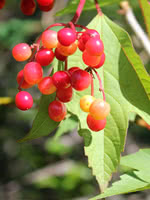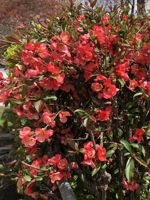Mon-Fri 9am - 5pm Mountain time
Highbush Cranberry vs Japanese Quince
Viburnum opulus var. americanum (trilobum)
Chaenomeles japonica
NOT AVAILABLE THIS SEASON - MIGHT RETURN
Highbush Cranberry produces attractive white flowers in late June and bears edible fruit that matures to a bright red colour in the late summer.
This shrub, native to much of Canada, is fast growing, and its fruit can be eaten raw or cooked into a sauce.
Japanese Quince has bright, orange to red showy flowers that bloom in early spring. The flowers appear before the leaves and may continue to bloom after leaves emerge. Flowers grow on old wood, so pruning after flowering will help to promote new growth next spring. They produce yellow-green fruit that taste bitter when eaten raw, typically they are better suited for making preserves.
It can be used as a stand alone ornamental shrub, as a low hedge, or can be trained to grow against a wall. In late winter, branches of Japanese Quince can be cut and brought indoors where they will bloom on their own. They are deer and rabbit tolerant. The branches are spiny making them well suited for keeping unwanted wildlife away.
Highbush Cranberry Quick Facts
Japanese Quince Quick Facts
In row spacing: 0.6 m (2.0 ft)

